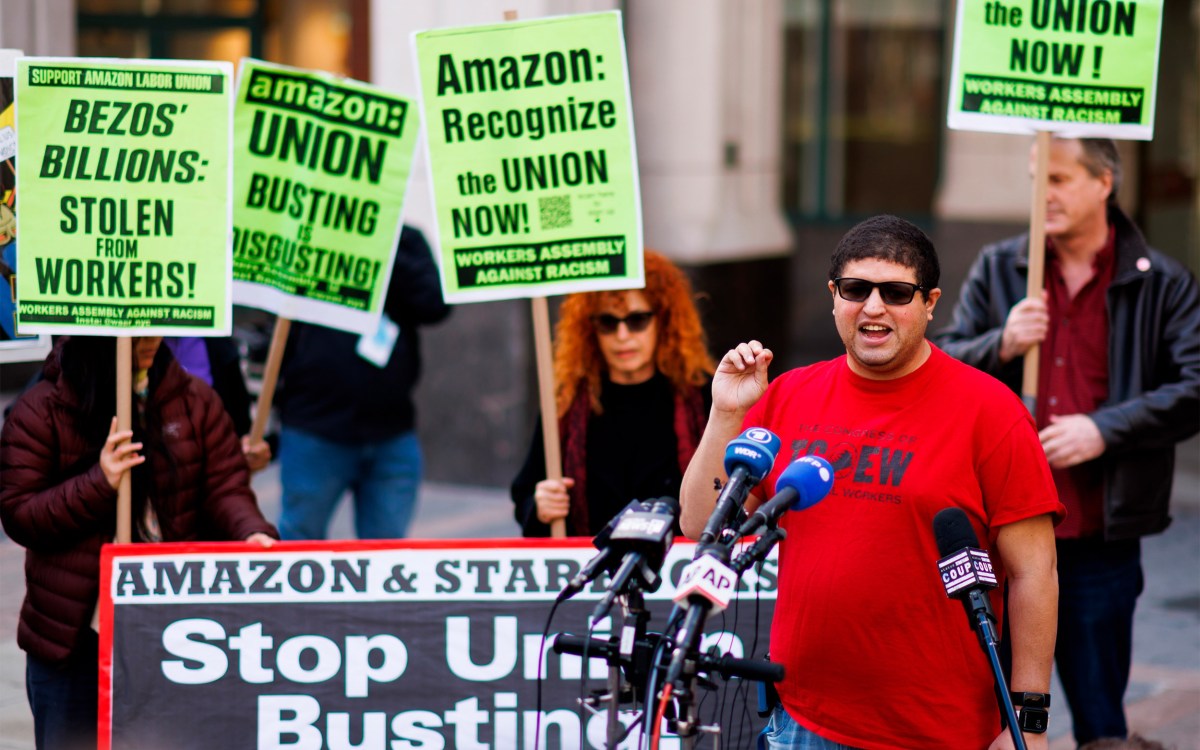Back to office? Stay remote? Go hybrid?
Bosses shouldn’t just go with their guts, and consensus may not work. Start by deciding what really matters, business professor says.

Illustration by Otto Steininger
Since the rollout of COVID vaccines, many businesses have brought workers back full-time. But many workplaces either remain remote or have adopted a hybrid model, with staffers coming in some days and working from home others. This recent “Return to Office” push is meeting resistance from some employees.
Ethan S. Bernstein, Edward W. Conard Associate Professor of Business Administration at Harvard Business School, is an organizational behavior expert who has been studying how the workplace has been changing since the start of the pandemic. He spoke with the Gazette about why going back to the office is straining many workplaces and how employers and employees can work together to find an arrangement that works for everyone. Interview has been edited for clarity and length.
Q&A
Ethan S. Bernstein
GAZETTE: Many employers want workers back in the office but are facing pushback from employees who want to continue working remotely. What’s making this situation so fraught and difficult to figure out?
BERNSTEIN: Doesn’t it seem silly that, in a moment of crisis during the pandemic, we all figured out how to keep working productively without all these conversations and debates, seemingly because we were just rolling up our sleeves collectively and getting work done? And now that we have the choice, it’s the choice that makes this hard.
The answer is twofold. Many of us, including my esteemed HBS colleague Tsedal Neeley, who has spent a lot of time on this topic, have referred to the contemporary office as just another management tool. If you see it that way, [as I do,] then part of the tension is that there are different views and different preferences as to how that tool should be used. We’ve never really had that conversation to this degree before. Yes, some organizations have never had offices; others have had virtual employees for a long time. But with hybrid work becoming widespread, so too has the choice we have as to where and how to work. It can’t just be an individual choice — how one person chooses to work affects how the team and the organization work, too. And so, for the first time, we’re facing the dilemma of whose preference matters and whose doesn’t. We might wish for data and evidence to show us the way, but right now, the data is sparse, methodologies are imperfect, and it is unclear whether results that favor one kind of work over another are indicative of a superior choice or it’s just that people haven’t had enough time to make the alternative more viable.
My work on the open office showed that when we use our intuition, we don’t always get it right. We thought open offices were solving for collaboration and cost, but they were really only solving for cost. Similarly, when leaders bring people back to the office because they “know” that you can’t do x or y as well virtually, I think they are justifying their own preferences using unproven assumptions with limited or no relevant evidence.
The second reason why this conversation is so fraught is because the pandemic changed the labor market. Many employees now know what it feels like to choose and experiment with different ways of working. Those who liked having choice aren’t willing to give it up, and when choice is taken away, they are willing to walk. And we have a labor market that supports them doing so.
“This is the problem: Your decision to go into the office affects my decision to stay home and vice versa.”
GAZETTE: Before the pandemic, fears of lost productivity were a key reason employers resisted remote work. Two and half years later, data show that worry was unfounded and yet, employers are still pressing to cut back on remote work and revive the pre-pandemic office. Is this just a power struggle between management and employees?
BERNSTEIN: Generally speaking, I don’t think people are fighting because they want to express their power; they are fighting for what they genuinely believe is the right thing to do. I haven’t come across any leaders or managers of organizations that I don’t think are trying to do what they think is right. But they are basing what’s “right” on their set of preferences and their set of experiences. And different generations, different roles, different people — all the difference and diversity that we celebrate — is making this a hard problem to solve. It’s not a power struggle per se; just a lot of diverse (and strongly held) opinions.
It would help if we started by asking what we are optimizing for and then put our minds together to solve for that. Right now, some organizations seem to be falling into the consensus trap: We don’t know what to do, so let’s strike a middle ground and do two to three days in the office. But those organizations are finding that approach doesn’t really produce anything beyond a suboptimal consensus. Perhaps certain kinds of collaboration improve when all collaborators are simultaneously in the office, but does that happen when each person picks two to three days? No. Does that solve a productivity problem? Well, no — it doesn’t really seem as if we have a productivity problem. Does that solve a mental health problem? Probably not unless we find a way to integrate it with activities that will make people happier [working] at the office, as opposed to home.
And so, if consensus isn’t the solution, then how do we get to a common understanding? For that reason, I don’t begrudge the experimentation that leaders in organizations are making. I’d love to see the experiments be a little bit more balanced and a little bit more inclusive of diverse views, but beyond that, any experiment that allows us to learn is a good experiment in these early days. The tight labor market is forcing experimentation where it wouldn’t naturally happen. There is not going to be one solution that fits all — in fact, looking back, it’s crazy that we thought there was when we were used to in-office work.
With that in mind, organizational leaders would do well to experiment with solutions that contradict, rather than support, their own preferences and gut instincts. Instead of assuming that what they think is best for the organization, be more intentionally, deliberately open, incorporating as many different views (and experiments) as possible. That’s the promise of hybrid that makes its cost worthwhile. Everyone is saying the solution is “hybrid,” but they all mean something slightly different when they say that word. The way we make progress is by trying out all the different meanings until we find the version that works for us.
GAZETTE: Do we have any data yet to show whether hybrid work is helping or hurting business performance?
BERNSTEIN: I wish I did. We know how to make in-office work work and because of the pandemic, we know how to make virtual work work. The only thing we don’t know how to do is hybrid. Figuring it out is going to take time. Those who do, however, will be ahead of the game. That’s why it’s good that we’re doing this now. It very well may be a competitive advantage in the near future.
GAZETTE: What approach should organizations take if they’re genuinely trying to identify a solution that will meet the needs of both management and employees?
BERNSTEIN: If any of my students were asked, “How do we come to some consensus for how we do our work?” the first answer would be: Let’s decide what matters. We can’t necessarily do that organization-wide because different groups, teams, functions, etc., are going to need different things — so let’s solve this at that level. Then, once we’ve agreed what we’re trying to solve for, let’s track it and see if we can solve for using the preferences of the people in [those] roles. It can’t just be [about] individuals. This is the problem: Your decision to go into the office affects my decision to stay home and vice versa. And it might affect my productivity metric as much as yours when you decide to be somewhere other than where I am. And so, we need to have a collective approach to this.
HR is supposed to help us manage these things and enlightened, strategic HR is doing exactly this: What are we trying to solve for? How do we track it? How well are we doing on it? And what modifications do we need to experiment with to make it better? Only once we’ve really tried to prove that we can make our preferred way of working work and failed, should we throw up our arms and admit to ourselves, “OK, you’re right. I need to spend more time in the office than I would like because it’s good for the team” or “Maybe this isn’t the right role for me because [it] requires being in the office because of the way this work is done”? It would help to start from basic principles rather than starting from the view that hybrid work is somehow so different from any other kind of work. My own view is, if we do that, we’ll never get to the point where we wave the white flag and be required to head “back” to the office. Give it five to 10 years, and I expect we’ll be shocked we ever thought that was true.
GAZETTE: Beyond Zoom, can technology solve some of the challenges that hybrid work poses?
BERNSTEIN: Absolutely. We should all remember that the technologies that make virtual work possible are relatively new. The smartphone was only invented about 15 years ago, so imagine what technology might emerge in the next 15 years to better enable hybrid work. That said, we can’t just push this issue onto technology companies. We should be clearer about what problems we need solved and, more importantly, be more open to using the emerging technology that is becoming available. Many organizations already have technology to solve some of these issues — managers simply are choosing not to use it.
GAZETTE: How can employers and employees negotiate an arrangement that works for everyone?
BERNSTEIN: I really hope this doesn’t always have to be a negotiation. There’s so much we don’t know and can learn together before we negotiate sides. How do we do a better job of learning? First, we might step back from the survey as our primary source of data. Surveys are great for getting average perspectives across broad samples, but this should be an ongoing conversation. Good conversation starts with the desire to understand, so let’s try to understand the source of the tension, the assumptions behind it, and test those assumptions. No one is entirely happy with the way things are working right now, so let’s understand, surface, and test those areas where everyone would like to see progress, and let’s save the negotiating tactics and split-the-baby suboptimal consensus for later.
GAZETTE: The type of “consensus” where everybody gets a little of what they want, but no one is happy.
BERNSTEIN: And then someone says, “Well, I guess the experiment failed, so the answer is to bring everyone back to the office.” That’s just too simplistic. We can do better.







